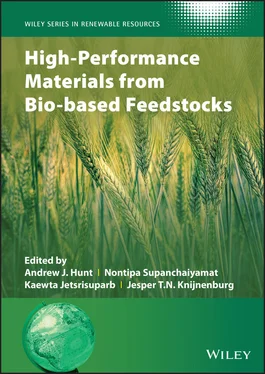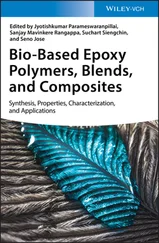High-Performance Materials from Bio-based Feedstocks
Здесь есть возможность читать онлайн «High-Performance Materials from Bio-based Feedstocks» — ознакомительный отрывок электронной книги совершенно бесплатно, а после прочтения отрывка купить полную версию. В некоторых случаях можно слушать аудио, скачать через торрент в формате fb2 и присутствует краткое содержание. Жанр: unrecognised, на английском языке. Описание произведения, (предисловие) а так же отзывы посетителей доступны на портале библиотеки ЛибКат.
- Название:High-Performance Materials from Bio-based Feedstocks
- Автор:
- Жанр:
- Год:неизвестен
- ISBN:нет данных
- Рейтинг книги:5 / 5. Голосов: 1
-
Избранное:Добавить в избранное
- Отзывы:
-
Ваша оценка:
- 100
- 1
- 2
- 3
- 4
- 5
High-Performance Materials from Bio-based Feedstocks: краткое содержание, описание и аннотация
Предлагаем к чтению аннотацию, описание, краткое содержание или предисловие (зависит от того, что написал сам автор книги «High-Performance Materials from Bio-based Feedstocks»). Если вы не нашли необходимую информацию о книге — напишите в комментариях, мы постараемся отыскать её.
High-Performance Materials from Bio-based Feedstocks
The latest advancements in the production, properties, and performance of bio-based feedstock materials
www.wiley.com/go/rrs High-Performance Materials from Bio-based Feedstocks
High-Performance Materials from Bio-based Feedstocks
High-Performance Materials from Bio-based Feedstocks — читать онлайн ознакомительный отрывок
Ниже представлен текст книги, разбитый по страницам. Система сохранения места последней прочитанной страницы, позволяет с удобством читать онлайн бесплатно книгу «High-Performance Materials from Bio-based Feedstocks», без необходимости каждый раз заново искать на чём Вы остановились. Поставьте закладку, и сможете в любой момент перейти на страницу, на которой закончили чтение.
Интервал:
Закладка:
150 150. Das, V.K., Shifrina, Z.B., and Bronstein, L.M. (2017). Graphene and graphene‐like materials in biomass conversion: paving the way to the future. Journal of Materials Chemistry A 5 (48): 25131–25143. https://doi.org/10.1039/c7ta09418c.
151 151. Jurca, B., Bucur, C., Primo, A. et al. (2019). N‐Doped defective graphene from biomass as catalyst for CO2 hydrogenation to methane. ChemCatChem 11 (3): 985–990. https://doi.org/10.1002/cctc.201801984.
152 152. Huang, B., Xia, M., Qiu, J. et al. (2019). Biomass derived graphene‐like carbons for electrocatalytic oxygen reduction reaction. ChemNanoMat 5 (5): 682–689. https://doi.org/10.1002/cnma.201900009.
153 153. Wu, L., Song, J., Zhou, B. et al. (2016). Preparation of Ru/graphene using glucose as carbon source and hydrogenation of levulinic acid to γ‐valerolactone. Chemistry – An Asian Journal 11 (19): 2792–2796. https://doi.org/10.1002/asia.201600453.
3 Starbon ®: Novel Template‐Free Mesoporous Carbonaceous Materials from Biomass – Synthesis, Functionalisation and Applications in Adsorption, and Catalysis
Duncan J. Macquarrie, Tabitha H.M. Petchey and Cinthia J. Meña Duran
Green Chemistry Centre of Excellence, Department of Chemistry, University of York, York, UK
3.1 Introduction
Porous materials are of great importance in a wide range of applications, including adsorption, catalysis, energy applications and composite materials. The majority of these materials are microporous; from the International Union of Pure and Applied Chemistry(IUPAC) definition [1, 2] they contain pores of <2 nm. In reality, the pores are generally constrained to <1 nm, making them able to adsorb small molecules within their pore structure, whereas larger molecules can only adsorb externally, meaning that the majority of the surface area is unavailable. Long micropores also suffer from diffusional issues, and it is recognised that much of a pore system may indeed play little role in the material’s performance.
These issues have driven research into the development of mesoporous materials (IUPAC definition encompasses pores from 2 to 50 nm) which allow much faster diffusion and thus utilise a greater proportion of the pore system. These larger pores are generally less easily blocked than the much smaller micropores, but a proportion may have constrictions such as the classic ‘ink bottle’ shape with a narrow entrance to a much larger space. It is very much possible that the mesoporous materials also contain micropores, and the mesopores may play a role in improving access to the micropores.
While (amorphous unstructured) mesoporous materials such as silica and alumina have been known for decades, more regular materials took much longer to develop. It was the early 1990s that saw an explosion of methodologies that delivered a wide range of very controllable routes to highly regular structured materials, largely silicas, but also a few alumina systems and others were developed [3, 4]. This work served to illustrate the advantages of mesoporosity, with a range of applications being demonstrated.
While these strides were being made in inorganic materials, the field of carbon was still dominated by predominantly microporous activated carbons, generally prepared in two steps. The first step is the thermal decomposition of waste biomass, which is followed by a chemical ‘activation’ step. This second step usually involved reaction with metal species (KOH and ZnCl 2in large quantities) or gases (oxidants such as oxygen or CO 2) in order to open up the structure and generate some mesoporosity. Nonetheless, these materials remain predominantly microporous.
The enormous activity in well‐defined, highly mesoporous inorganic materials led to their use as templates, including for carbon, and various groups have published work showing that the mesopores could be filled with organic material which could then be carbonised [5, 6]. Removal of the inorganic template then gave an inverse replica carbonaceous material that often displayed mesoporosity.
These so‐called hard templating methods provide a wide range of well‐ordered materials [7] but have the drawback of complex and wasteful syntheses, destroying both the template for the silica and the silica itself. An elegant approach has recently been put forward by Jiang et al. [8] who coated the internal surface of mesoporous silicas with a layer of carbon, leading to carbon silica composites (CSCs). Such CSCs directly replicate the porosity of the silica but have a carbonaceous surface. This route is simpler, less wasteful, and retains positive features from the silica, including mechanical strength and the variety of pore architectures that silica can have.
Another approach, first published in 2006, utilises the inherent structure of certain polysaccharides to expand to give mesostructured hydrogels [9]. With suitable drying strategies, these gels can be dried and the resultant aerogel is pyrolysed to provide a highly mesoporous material with excellent pore volume, surface area, and importantly, tunable surface properties ranging from polysaccharide‐like at lower pyrolysis temperatures to carbon‐like at higher temperatures. While the process consists of three stages, it does not involve templating, instead relying on the inherent properties of the starch to assemble into naturally mesoporous structures. These materials are known as Starbon ®, from a combination of star ch and car bon , and will be the focus of this chapter. Starbon has been commercialised by Starbons Ltd.
3.2 Choice of Polysaccharide
The choice of polysaccharides is a key aspect of the synthesis of Starbon. Not all polysaccharides have been successfully expanded and carbonised using the Starbon approach, notable examples which have proved impossible being cellulose and chitosan. On the other hand, various starches, alginic acid [10], and pectin [11] all readily form mesoporous structures under the appropriate conditions, and these mesostructures can be successfully translated into carbonaceous materials. Recently, Attard et al. [12] have demonstrated that chitosans can be successfully incorporated into Starbon materials via mixing with alginic acid over a range of compositions, maintaining porosity while, at the same time, incorporating nitrogen.
3.2.1 Synthetic Procedure
3.2.1.1 Gelation
The formation of Starbon, irrespective of the nature of the polysaccharide, has three distinct stages (gelation, drying, and pyrolysis). First, gelation of the polysaccharide takes place in water to swell the material (starch, for example, exists in nature as densely packed granules and functions as an energy source) to produce a hydrogel. The gelation is promoted by a combination of temperature and shear forces, which aid in breaking up the tightly packed grain, allowing some of its contents to move outwards, creating porosity. A subsequent step is a retrogradation, where the gel is allowed to ‘rest’ at 4 °C for approximately 24 hours. This causes slight structural changes and stabilisation.
3.2.1.2 Drying of the Hydrogel
A critical stage is the subsequent drying step, as direct drying of the hydrogel leads to extensive collapse. This is due to the material being relatively soft and structurally weak compared to the significant capillary forces generated on the evaporation of water from the surface of a meniscus ( Figure 3.1). These forces act to pull the walls of the pore together, causing collapse if the material is mechanically weak, which is the case with soft polysaccharide gels.
The fact that water has high surface tension and that it forms menisci in nanopores means that direct drying of the hydrogel puts the structure under great stress as the evaporation causes the pore walls to be pulled together – these forces are too great for the porous starch network to survive and structural collapse ensues. Roundabout methods, therefore, need to be utilised in order to avoid these forces and maintain the porosity.
Читать дальшеИнтервал:
Закладка:
Похожие книги на «High-Performance Materials from Bio-based Feedstocks»
Представляем Вашему вниманию похожие книги на «High-Performance Materials from Bio-based Feedstocks» списком для выбора. Мы отобрали схожую по названию и смыслу литературу в надежде предоставить читателям больше вариантов отыскать новые, интересные, ещё непрочитанные произведения.
Обсуждение, отзывы о книге «High-Performance Materials from Bio-based Feedstocks» и просто собственные мнения читателей. Оставьте ваши комментарии, напишите, что Вы думаете о произведении, его смысле или главных героях. Укажите что конкретно понравилось, а что нет, и почему Вы так считаете.












